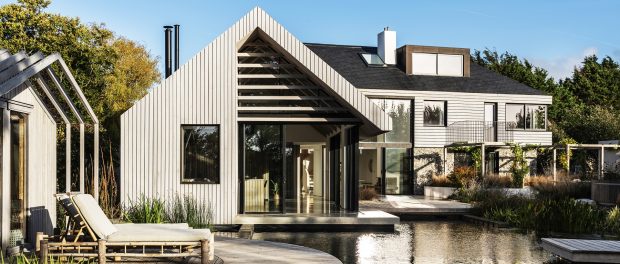Able Canopies creates bespoke shelter for university transport hub
As part of a £5 million infrastructure development for Bournemouth University, a new bus hub has been built to offer bus passengers a high-quality purpose-built facility for their journeys to and from the Talbot campus. Together with Atkins architects, Able Canopies designed and erected two bespoke canopies providing shelter for the hub and incorporating transparent photovoltaic glass technology into an attractive, practical and modern design.
Bournemouth University was looking to build a large capacity bus hub aimed at improving the quality of its bus service by providing bus users with central and convenient access to the Bournemouth’s Talbot Campus, improved sense of arrival and allowing for future growth in bus use.
Construction company Mildren Construction was selected to deliver this project and awarded the detailed design and build of the bus hub canopy to Able Canopies, who created a bespoke solution that built on the merits of one of its bestselling products.
Josh Foord, technical sales manager at Able Canopies was involved heavily with the specification process. On the design he commented: “The shelter had to complement the design concept of the bus hub and had to deliver on the University’s sustainability goals by utilising transparent photovoltaic glass technology to increase on-site energy generation capacity. A bespoke solution based on our stylish Kensington system allowed us to meet those needs and build in effective drainage, seating and under canopy wind protection.”
Able Canopies’ successful Dual-Pitch free-standing Kensington was an ideal solution, allowing for the easy incorporation of the additional elements required by the site. Two Kensington canopies were created, measuring approximately 22 x 5m each, from a powder-coated and hot dip galvanised steel frame and ten-millimetre thick toughened glass panels, alongside the solar glass inserts. With its robust steel frame, the structure is able to withstand all weather conditions. The Kensington system is able to withstand wind downforce of 0.46kN/sqm and a uniform snow load of 0.6kN/sqm[1].
The canopies’ unique styling provides a strong aesthetic statement with an incline from three metres in height in the middle of the hub to four meters at the hub’s ends. Bespoke rounded glass end panels were also fitted to each end of the hub to create a stylish finish. Having previously used the Kensington on installations where solar power was required, the Able Canopies team knew that solar integration would be possible, as requested by the Bournemouth University specification.
Throughout this process Able Canopies worked closely with the solar glass provider and with some minor alterations to the system the panels were able to fit perfectly into the Kensington roof.
Another key consideration was how the solar panel cables were going to be concealed but easily accessed for maintenance at a later date. To achieve this, access panels were installed in the two support posts at the taller end of each canopy. One post carries the DC cables from the solar panels and the other carries the AC cables for the lighting. The two posts at the other end of each canopy were designed to be integral rain water pipes which disperse all water from the roof into a drainage connection below the paving.
Josh continued: “The result was a standout look for a practical transport hub, providing effective weather protection and a long-term pay-back via renewable energy generation. The project demonstrates the opportunities available to organisations to maximise the use of roof panels and turn what could be seen as dead space into an added value shelter with renewable energy generation.”
Marcin Grabowski, programme manager at Bournemouth University Estates, said: “I think it was a great idea to change the originally proposed bespoke canopy with timber roof to a product based on an established system that not only looks great but will provide continuous return both in terms of carbon and capital expenditure. The power generating canopy is just one example of how the Bournemouth University is investing to reduce its environmental impact and it is expected to save up to 8 tons of CO2 per year, contributing to Bournemouth University’s carbon reduction target of 40% by 2020/21. Overall, we have enjoyed working with Able Canopies and are looking forward to more future ventures involving new, green technologies.”
With a life expectancy of up to 25 years, dependant on finish, Able Canopies’ Kensington Dual-Pitch is ideal for a range of applications within the education and leisure industry, providing shelter for outdoor education, dining, car parks and waiting areas. With the addition of solar panelling, a Kensington can create a safe and comfortable space with an ecological outlook – allowing for the generation of renewable energy for use in and around the canopy.
www.ablecanopies.co.uk/canopies/
[1] These are generic wind and snow load calculations for The Kensington system. Site specific calculations are always available for individual installations.




















